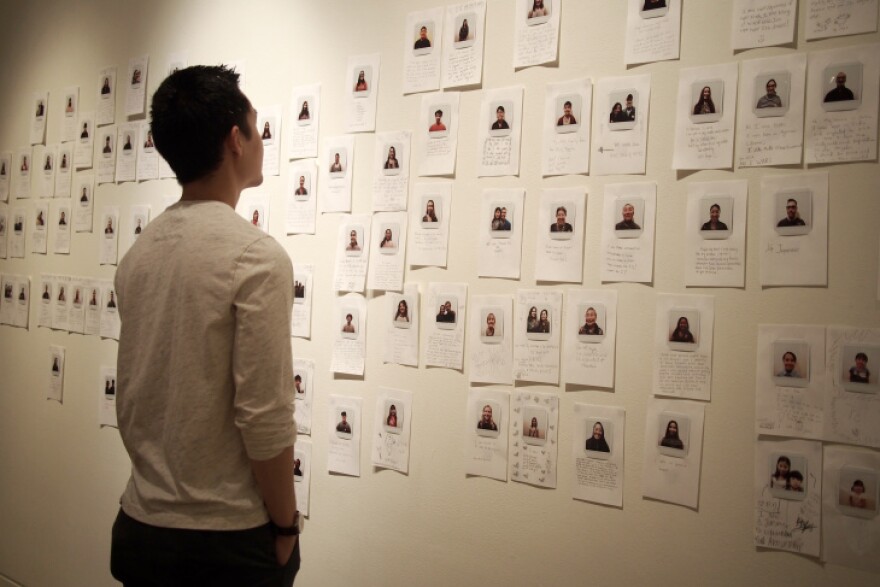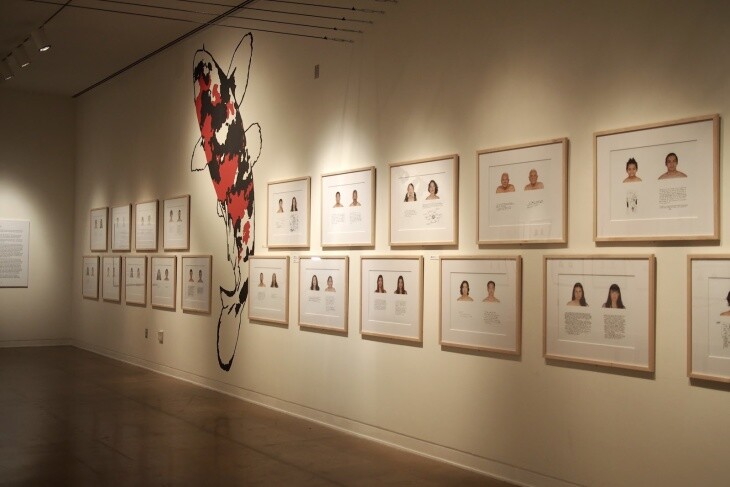Congress has cut federal funding for public media — a $3.4 million loss for LAist. We count on readers like you to protect our nonprofit newsroom. Become a monthly member and sustain local journalism.
Are You Hapa? This Exhibition Invites You To Explore Identity, Whether You're Mixed-Race Or Not

"What are you?"
It was in 2001 that artist Kip Fulbeck started asking people that question as he shot their portraits. His subjects, like him, identified as "Hapa," or mixed-race. The question was meant to elicit a sort of "statement of identity," or how they saw themselves in the world.
Some of the responses: "I am a daily contest to guess what I am." "I'm a girl. I'm American. I'm seven. I am Hanna." "My last boyfriend told me he liked me because of my race. So I dumped him."
Fulbeck's initial "Hapa Project" included about 1,200 people and led to the 2006 book, Part Asian, 100% Hapa. In a new exhibition at the Japanese American National Museum, "Hapa.me - 15 Years of the Hapa Project," Fulbeck returns to the original participants 15 years later, with updated portraits and statements.
"The project isn't even about race," Fulbeck said. "The project is about identity. It just uses race as a starting point to talk about it."

Fulbeck told LAist he wanted to discover other people who identify this way and also show how they are not necessarily alike.
"People always say, 'Oh, you finally found your tribe.' No. We have nothing in common besides we couldn't fill out a form correctly, because it says pick one box," he said. "I think showing that diversity of the 7+ million Hapas in the U.S. was really important to me."
The term "hapa" has its roots in the Hawaiian language and means "mixed" or "part." That includes referring to someone with mixed Native Hawaiian heritage. Over time, it has been adopted by many other people of mixed ethnic background, in particular those in Japanese American and other Asian American communities. Fulbeck's personal understanding of the term has evolved over time.
"When I grew up [in] 1970 L.A. County, my cousin told me, 'You're Hapa.' So I grew up thinking, 'Oh, that must mean you're Chinese-English-Irish,'" Fulbeck said.
But eventually he met others who identified as Hapa, and then he lived in Hawai'i, where he said the definition is completely different. "I've had people tell me, 'Why'd you include some of these people that are Asian-Asian? That's not Hapa.' I was like, 'You don't get to tell them who they are.'"

Fulbeck kept a consistent format and aesthetic for each photo throughout the project.
"Everyone's shot the same way," he said. "Collarbone up, looking straight at the camera, no expression, no jewelry, no glasses, no heavy makeup. I wanted it as neutral as possible."
Then he'd ask them to handwrite their statement of identity.
"Writing a statement on a blank piece of paper -- who you are, that's a big question," Fulbeck said. "Some people, they come in with 10 statements already written. I realized it's really profound. Sometimes we've never been asked. That's all I'm asking people to do: be vulnerable, be yourself."
On select days, visitors to the exhibit can participate by getting their portrait taken and writing their own statement to go along with it.

"I always feel like identity is a completely personal process and you're right to call yourself what you want to call yourself," Fulbeck said. "No one gets to tell you who you are, and so basically I said if you want to fall under this rubric of what you think Hapa is, then be part of the project."
For Fulbeck, hapa.me marks the end of the Hapa Project.
"I hope that people that are not Hapa see this thing and start realizing that the world is much, much bigger than this black/white paradigm that we live in," Fulbeck said. "I want people to come in to see that the world is so much bigger and that our stories matter. I do love when I hear from the many, many people that told me that the project changed their lives. That's completely humbling. It's why I made the project."
"hapa.me - 15 years of the Hapa Project," runs through October 28th at the Japanese American National Museum, in Little Tokyo, Downtown Los Angeles.
You made it! Congrats, you read the entire story, you gorgeous human. This story was made possible by generous people like you. Independent, local journalism costs $$$$$. And now that LAist is part of KPCC, we rely on that support. So if you aren't already, be one of us! Help us help you live your best life in Southern California. Donate now.
As Editor-in-Chief of our newsroom, I’m extremely proud of the work our top-notch journalists are doing here at LAist. We’re doing more hard-hitting watchdog journalism than ever before — powerful reporting on the economy, elections, climate and the homelessness crisis that is making a difference in your lives. At the same time, it’s never been more difficult to maintain a paywall-free, independent news source that informs, inspires, and engages everyone.
Simply put, we cannot do this essential work without your help. Federal funding for public media has been clawed back by Congress and that means LAist has lost $3.4 million in federal funding over the next two years. So we’re asking for your help. LAist has been there for you and we’re asking you to be here for us.
We rely on donations from readers like you to stay independent, which keeps our nonprofit newsroom strong and accountable to you.
No matter where you stand on the political spectrum, press freedom is at the core of keeping our nation free and fair. And as the landscape of free press changes, LAist will remain a voice you know and trust, but the amount of reader support we receive will help determine how strong of a newsroom we are going forward to cover the important news from our community.
Please take action today to support your trusted source for local news with a donation that makes sense for your budget.
Thank you for your generous support and believing in independent news.

-
Children asked to waive right to see a judge in exchange for $2,500
-
There’s still a lot to be determined as the refinery, which supplies about one-fifth of Southern California's vehicle fuels, works to restore production and as data is collected.
-
The FCC voted to end E-Rate discounts for library hotspot lending and school bus Wi-Fi.
-
About half the Pacific Airshow’s 2025 lineup has been grounded because of the federal government shutdown.
-
USC says it’s reviewing the letter also sent to eight other prestigious schools nationwide. California's governor vowed that any California universities that sign will lose state funding.
-
Scientists say La Niña is likely, but that doesn’t necessarily mean a dry winter in Southern California.







